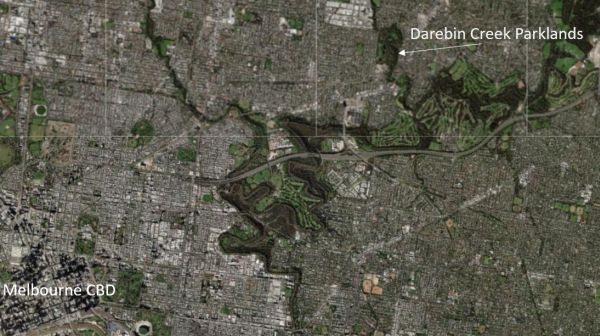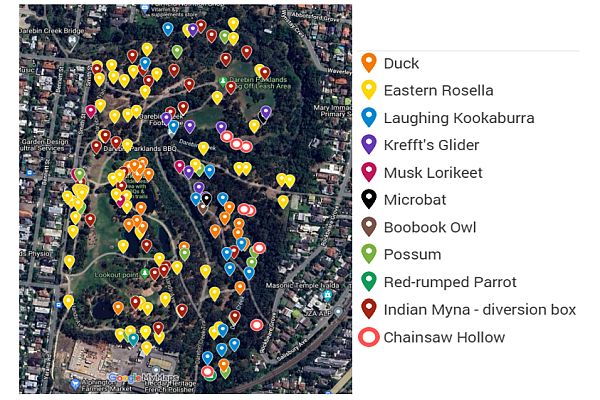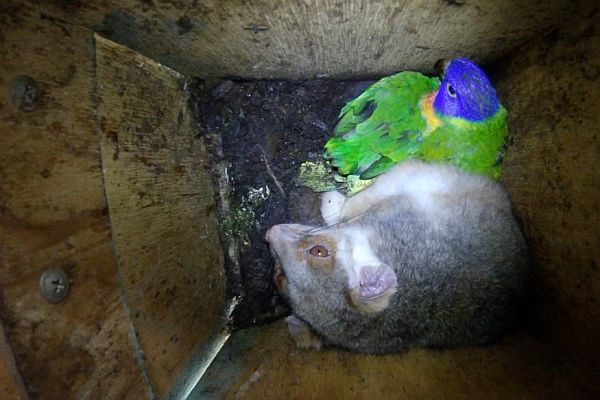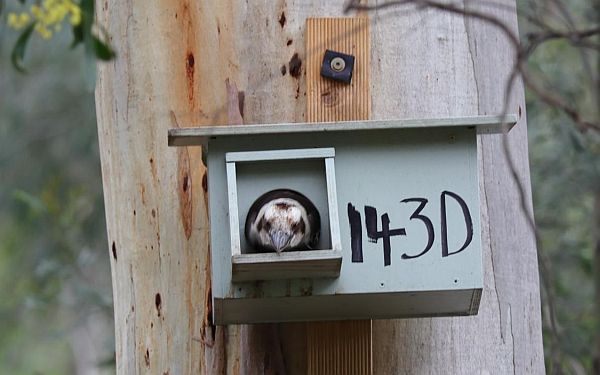Darebin Parklands Nest Box Program
(Darebin Creek Management Committee)
About the Nest Box Program
For 16 years, Rangers and volunteers have been installing, maintaining, monitoring and researching nest boxes around the 32ha Darebin Parklands. The Management Committee currently have ~150 boxes and 11 chainsaw hollows that are monitored every three weeks using a nest box camera.
Updated results can be found via social media (Instagram: darebin_parklands) and Darebin Parklands Committee website
Various species of wildlife are targeted and many animals use the boxes throughout the year.
How it all started
Senior Ranger Peter Wiltshire noticed an Eastern Rosella trying to get inside a power pole slot to nest. By observing and realising what the bird was trying to do, a quick nest box was made and installed. Soon after, Eastern Rosellas were observed successfully nesting inside the box, and the program kicked off! The park as it’s known now is still fairly young (50 years old) hence the lack of mature trees with hollows. Nest boxes installed are targeted at hollow-dwelling species found in the park. There are some target species that are yet to successfully use boxes (e.g Red-rumped parrots, Musk lorikeets)

Left: power pole slot Eastern Rosella attempted to nest in. Middle: Rosella investigating new nest box Right: Eastern Rosella chicks.
Darebin Parklands

Darebin Parklands is situated on the Darebin Creek approximately 7 km north-west of the Melbourne CBD. The Parklands are surrounded by urban development and now form an important habitat refuge and part of a bioink along the Darebin Creek and Yarra River.
Darebin Parklands has been dramatically altered from a farm and quarry in the 1800’s to a tip site and wasteland in the 1960’s and has now been revived as an urban bushland park for wildlife and enjoyed by the community. The Darebin Creek runs through the center of the park which divides it ecologically and geologically. Due to past clearing and major disturbance, most of the vegetation in the park is young and there has been a lack of tree hollows for decades.
Nest box monitoring
Data collected helps the management committee understand:
- what species are in the park and are using the boxes
- what styles of boxes different species use
- how we can improve habitat restoration
- importance of the location of boxes
- nesting and breeding behaviours
- approximate population numbers within the park

Overall, there has been a 52% occupancy in the nest boxes.
Main species found in nest boxes
- Gould’s wattled bat
- Krefft’s glider
- Brushtail possum
- Ringtail possum
- Laughing kookaburra
- Eastern rosella
- Rainbow lorikeet
- Australian wood duck
- Chestnut teal duck
- Dusky moorhen (in floating nest boxes)
- Indian Myans - invasive

A Common Ringtail Possum & two Rainbow Lorikeet chicks were found sharing a box numerous times. Lorikeet parents were observed flying in and out while the possum was also in there. The chicks survived and fledged. This has only occurred once in the parklands to our knowledge.
Please contact the committee if you know whether it has been observed anywhere else? Contact form.
Nest box research
Years of trials and research has been undertaken to improve how the boxes are made, erected and used.
Indian Myna & Starling exclusion
-
- After many trials of building all kinds of snouts, baffles and flaps to exclude Mynas and Starlings but to still allow Eastern Rosellas to enter, we found that the Mynas and Starlings could still enter boxes easily and weren’t deterred by the obstacles but the Rosellas had given up and would/could not enter the boxes
- Darebin Parklands found the numbers of Eastern Rosellas were decreasing as the numbers of Indian Mynas were increasing. Also, the few Rosellas that did nest, ended up with their chicks dead outside of the nestboxes. We assumed that the Indian Mynas were responsible for this so a Myna trapping program was implemented. As we lowered the Myna numbers, the Rosellas came back and were able to successfully rear chicks. Subsequent research with cameras inside and outside of nestboxes has shown Indian Mynas entering a nestbox and removing and destroying the Rosella eggs. Indian Mynas will also destroy Starling eggs and remove young Starling chicks from a nestbox. Indian Mynas have also been videoed entering nestboxes and attacking both adult Eastern Rosellas and Starlings.
- Currently, we ensure to clean out any Indian Myna nests, eggs and chicks and use external myna traps to reduce numbers
Morre information on Indian Myna webinar Peter Wiltshire presented to Yarra Ranges Council
Nest Box Design
Studies have shown that lighter coloured nest boxes keep cooler if direct sun falls on them so we use a white-based light green, water-based paint. On the very hot days, nest boxes will heat up to the ambient temperature.
-
- Thinking about thermal properties appropriate for wildlife but taking into consideration cost of making a box, ease of putting it up (weight) and longevity, the group found 19mm untreated dressed pine box the best option thus far. 12mm marine ply is used for the Duck and Kookaburra boxes. A maintenance panel is built in, allowing easier access to clean out a box rather than reaching up and going in from the lid.
- The group is currently still monitoring and researching thermal properties and materials to improve nest box quality for wildlife.
- Over the years the group has found the easiest and safest way to attach the nestbox to the tree is by first attaching a backing plate to the tree with 2x climacoat bugle head screws. Treated pine decking is used for the back plate and put a block of the decking between the screw and plate which will slowly break as the tree grows and pulls the screw through. The block can be replaced. Do not use galvanized screws as they tend to corrode and stick to the tree. The nestbox has a key hole in the back that fits over a small bugle head screw in the backboard. This design makes the nestbox easy to safely remove and replace. It has been found that by placing a small piece of wood at the bottom of the nestbox it helps to stabilize the nestbox from moving when a possum jumps on the roof.

More information
- Featured videos of the nest box program:
- Darebin Parklands fauna monitoring
- Contact form
Other nest box related projects featured on SWIFFT
Brush-tailed Phascogale Nest Box project – Bendigo
Turquoise Parrot Nest Box project - Goulburn Broken, north-east Vic.
Campaspe Squirrel Glider project – Echuca area
Brisbane Ranges, Brush-tailed Phascogale project – near Geelong


